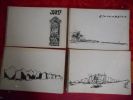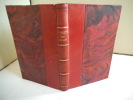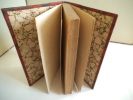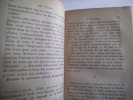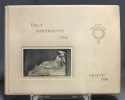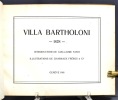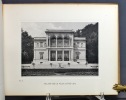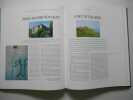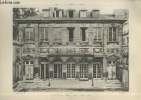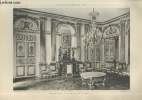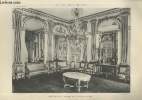-
Type
Any type (2)
Art print (7)
Book (31574)
Disk (1)
Drawings (7)
Engraving (9)
Magazine (125)
Old papers (1)
Photographs (14)
Posters (4)
-
Latest
Last 24h (7)
Last 3 days (12)
Last month (455)
Last week (114)
-
Language
Dutch (1)
English (52)
French (31647)
German (6)
Italian (18)
Portuguese (9)
Spanish (11)
-
Century
16th (15)
17th (56)
18th (211)
19th (1571)
20th (9650)
21st (1705)
-
Countries
Belgium (9464)
Brazil (7)
Canada (108)
China (1)
Côte d'Ivoire (66)
Denmark (218)
France (18771)
Germany (1)
Greece (1)
Italy (37)
Switzerland (3070)
-
Syndicate
ALAC (99)
CLAM (41)
CLAQ (94)
CNE (3)
ILAB (11108)
NVVA (1171)
SLACES (1171)
SLAM (8558)
SNCAO (9)
Lot de 4 cahiers d'esquisses - Deux sont titres "Bali" et "Camargue" et les deux autres sont sans titre
1977. 4 cahiers sans page de titre, sans editeur, les dessins sont dates entre 1970 et 1974. Format 28x19 cm, reliures a spirales, entre 30 et 37 pages chacune. Les dessins sont uniface. Les couvertures sont tres legerement salies, interieurs tres frais. Les 4 exemplaires comportent chacun un envoi manuscrit autographe de l'auteur .Bon etat.
mes voyages
la promenade d’extrême orient de Marseille à Saïgon - en Indo -Chine- en Chine- Les chinois peints par eux- mêmes- Au Japon-le vieux Japon- le Japon nouveau Paris Ernest. In 12 demi cuir rouge titre, roulette, nom en pied, dorés. Filets à froid sur les plats. Flammarion 1924.
Roman baths of Lycia : an architectural study = Likya'daki Roma hamamlari : mimari arastirmalari [Monograph (British Institute of Archaeology at Ankara), no. 20]
Ankara, British Institute of Archaeology, 1995 Original publishers paper-covered boards, 176 pages, 30.5 x 21 cm, English/Turkish. *As new. ISBN 9781898249047.
This volume examines the arrival and development of a distinctively Roman building type in an area of southwest Turkey where the numerous cities, who were highly competitive in their public building, left a remarkable wealth of ancient remains. Many new plans and photographs represent the full range of Lycian bath buildings. The building techniques employed and how Roman bathing habits fitted into the sporting life of Asia Minor under the Empire are also explored.
PYGM ES - Peintures sur corce battue des Mbuti (Haut-Za re).
Paris, Mus e Dapper, 1991 Cartonnage diteur in-4 (22 x 29,5 cm), toile noire sous jaquette originale, 168 pp., abondantes illus. en couleurs et n&b. ISBN 9782906067134.
Catalogue dit pour l'exposition du m me nom au Mus e Dapper, 30 mai-29 sept. 1991. D couvrez l'univers artistique et culturel des Pygm es du Haut-Za re (Ituri) au travers des corces battues peintes port es ou utilis es dans les c r monies rituelles. Les dessins g om triques sont fond s sur des codes graphiques qui affirment un art ancestral extr mement labor .
LA BASILIQUE DES SS. NEREE ET ACHILLEE ET LA CATACOME DE DOMITILLE.
Rome, Edizioni "Roma" Marietti, 1963 Broche, sous jacquette originale d'editeur, 17x12 cm., 95 pp. + plan pliable de la Basilique et de la partie la plus ancienne de la Catacombe en n/b, illustrations en n/b.
.
La collezione di riso museo d'arte contemporanea della sicilia
, Editore: regione siciliana (2009), 2009 Softcover, 128 paginas, Italiano, 240 x 175 mm, bon exemplare, . ISBN 9788861640962.
Mes belles po sies.
Paris, Librairie Istra, 1950-1960 Couverture rigide, 96 pages, 22.5 x 18 cm, Fran ais. * tat bien.
Choisies par Madame Marcelle Fassou, inspectrice g n rale des coles maternelles
Construire avec le peuple, histoire d'un village d'Egypte Gourna. La Bibliothèque arabe.
Paris, Editions Sindbad, 1977. 14 x 22, 312 pp., 132 illustrations en N/B, broché, couverture à rabats, bon état (couverture défraîchie).
"Texte définitif revu par l'auteur; traduit de l'anglais par Yana Kornel; liminaire de Pierre Bernard; seconde édition."
Genève et les Pays-Bas.
Genève - Haarlem, Edition du Journal de Genève - Edition de l’Eglise Wallonne sans date, vers 1920, 290x220mm, 154pages, reliure cartonnage. Couverture supérieure conservée. Nom du possesseur sur le haut de la page de garde supérieure. Bon état.
Pour un paiement via PayPal, veuillez nous en faire la demande et nous vous enverrons une facture PayPal
Genève à travers les siècles.
Genève, Société des Arts, 1900. Grand in-4 de 177 pages, demi-chagrin rouge à coins, dos à nerfs orné d'un fleuron doré, couverture et dos illustrés conservés, tête dorée. Reliure signée Asper.
Très nombreuses photographies in-texte en noir de Fred. Boissonnas. Histoire du développement architectural de Genève à travers les siècles. Étudie par ordre chronologique des vestiges archéologiques, puis architecturaux qu'a laissés derrière elle chaque période de l'histoire de la cité [Geisendorf 583]. Inscription sur garde.
[J.-J. Reymond, A. Pellegrini, C. Robida] - FATIO, Guillaume
Reference : 3588
(1904)
Ouvrons les yeux! Voyage esthétique à travers la Suisse
Couverture rigide Société genevoise d'édition ATAR 1904 Genève 30x25,5 cm
Reliure d'éditeur pleine toile beige avec titre et illustration, dos avec titre - 178 pp. Nombreuses illustrations représentant principalement des curiosités architecturales. Belle typographie. Bel état.
Villa Bartholoni 1828.
Genève, sans nom, 1918. In-4 à l'italienne de 15 pages suivies des planches, pleine toile grège, titre doré au premier plat qui est en outre orné d'une photographie en noir contrecollée. Ex-libris Edmond Chenevière.
44 planches en noir, dont 43 photographiques de Charnaux et frères. Un plan, hors-texte lui aussi, illustre l'introdution de Guillaume Fatio. Bel ouvrage, peu courant. Notre exemplaire est enrichi d'un envoi autographe signé de Jean Bartholoni à son ami Edmond Chenevière, banquier, philanthrope et maire de Cologny. "Achevée en 1830, la Villa Bartholoni a été bâtie selon les plans de l'architecte français Félix-Emmanuel Callet, grand prix de Rome, pour servir de résidence d'été au banquier genevois Jean-François Bartholoni. L'architecture de ce bâtiment s'inspire à la fois des villas palladiennes du nord de l'Italie et du néo-classicisme français, tout en adaptant sa taille aux dimensions et au confort de chauffage des demeures bourgeoises du 19e siècle. Si l'extérieur est plutôt sobre, sa luxueuse décoration intérieure s'inspire de l'Antiquité pompéienne. La marqueterie des parquets et des sols de marbre, les fresques murales, les stucs et les peintures des plafonds, déclinant des thèmes différents selon les pièces (personnages mythologiques, allégories ou animaux fabuleux), font de cette villa une œuvre d'art et une curiosité sans égale dans la région" [ville-geneve.ch]. Première planche tachée au coin inférieur.
Full Moon catalogus expo Voorlinden
Wassenaar, Voorlinden, 2023 Hardcover, 144 pages, full color, 29.7x24cm, Text in ENG/NL. ISBN 9789492549211.
Schilderkunst art kunst paint paint schilder Beaux Arts, Sciences antique antiek deco beeldhouwkunst beelden sculpturen Art & Architecture schilderen Kunst Fotografie Art, Histoire et patrimoine, Nouveaut s, art, arts plastiques, culture, histoire, livre, si cle Artiste peintre photo fotografie architectuur, lifestyle Hedendaagse kunst, Neo-expressionisme, Primitivisme
Les merveilles de l'Italie Venise la reine de l'Adriatique
Fattorusso G., Florence, Collection Médicis Collection Médicis (seconde série) Broché 1954 Les merveilles de l'Italie Venise la reine de l'Adriatique : L'architecture - les monuments - les oeuvres d'art - histoire et description. Collection Médicis n°5. In-12 (13 x 18,5 cm), broché, couverture illustrée en couleurs, 147 pages, 415 illustrations issues de la collection de Alinari frères et Giacomo Brogi de Florence et Anderson de Rome, toutes en noir et blanc sauf une en couleur en frontispice, couverture sous protection plastique : coiffes et coins légèrement frottés, quelques rousseurs sur les pages de garde, très bon état général. Livraison a domicile (La Poste) ou en Mondial Relay sur simple demande.
Les Merveilles de l'Italie...
Florence, G. Fattorusso, 1952. Coll. "Médicis". Nouvelle éd. revue et augmentée. In-8 cartonnage éditeur bleu, or et rouge, 670 p. 3275 ill. et 18 planches couleurs. Très bon état.... Les antiquités, les églises, les palais, les trésors artistiques, pour les étudiants et les touristes.
"Les Merveilles de l'Italie; les antiquités, les églises, les palais, les trésors artistiques pour les étudiants et les touristes. Collection : Médicis."
Florence, G. Fattorusso, 1962. 17 x 25, 621 pp., très nombreuses illustrations en couleurs et en N/B, reliure d'édition pleine toile, très bon état.
plat avant gravé en creux et doré.
Moscou 1900 - 1930. Vie quotidienne. Arts Plastiques. Littérature. Thêatre. Architecture. Musique. Cinéma.
Paris, Seuil, 1988, in-4to, 279 p., 295 ill. en couleurs et noir, exemplaire des archives de l’éditeur, tamponné. reliure en toile originale, jaquette orig. ill. en couleurs.

(SLACES, NVVA)
Phone number : 41 (0)26 3223808
LES FORTIFICATIONS DU LITTORAL . LA BRETAGNE SUD.
1998 LES FORTIFICATIONS DU LITTORAL . LA BRETAGNE SUD.Patrimoines et médias ,1998 , in4° cartonnage ill éditeur , 279pp.Abondantes illustrations.Très bon état.
Places fortes. Bastion du pouvoir.
Paris, REMPART - Desclée de Brouwer, Patrimoine vivant - Notre histoire, 1991. In-8 (210x150mm) broché ; 115 p. Ill. en noir. Très bon état général.
"Hôltel de Massa, rue de la Boétie n°111 : Façade sur la Cour d'honneur - Planche n°2 en noir et blanc extraite de l'ouvrage ""Les Vieux Hôtels de Paris : Le Faubourg Saint-Honoré Tome 1"""
"F. Contet. 1930. In-Plano. En feuillets. Bon état, Livré sans Couverture, Dos satisfaisant, Intérieur frais. Planche n°2 en noir et blanc extraite de l'ouvrage ""Les Vieux Hôtels de Paris : Le Faubourg Saint-Honoré Tome 1"". Dimensions : environ 44 x 32 cm.. . . . Classification Dewey : 720-Architecture"
Classification Dewey : 720-Architecture
"Hôtel de Charost : Chambre à coucher de la princesse Pauline Borghèse, détail du lit- Planche n°36 en noir et blanc extraite de l'ouvrage ""Les Vieux Hôtels de Paris : Le Faubourg Saint-Honoré Tome 1"""
"F. Contet. 1930. In-Plano. En feuillets. Bon état, Livré sans Couverture, Dos satisfaisant, Intérieur frais. Planche n°36 en noir et blanc extraite de l'ouvrage ""Les Vieux Hôtels de Paris : Le Faubourg Saint-Honoré Tome 1"". Dimensions : environ 44 x 32 cm.. . . . Classification Dewey : 720-Architecture"
Hôtel de Charost : Chambre à coucher de la princesse Pauline Borghèse, détail du lit Classification Dewey : 720-Architecture
"Hôtel de Charost : Grand Salon ionique du rez-de-chaussée, hauteur 5m25 - Planche n°34 en noir et blanc extraite de l'ouvrage ""Les Vieux Hôtels de Paris : Le Faubourg Saint-Honoré Tome 1"""
"F. Contet. 1930. In-Plano. En feuillets. Bon état, Livré sans Couverture, Dos satisfaisant, Intérieur frais. Planche n°34 en noir et blanc extraite de l'ouvrage ""Les Vieux Hôtels de Paris : Le Faubourg Saint-Honoré Tome 1"". Dimensions : environ 44 x 32 cm.. . . A l'italienne. Classification Dewey : 720-Architecture"
Hôtel de Charost : Grand Salon ionique du rez-de-chaussée, hauteur 5m25 Classification Dewey : 720-Architecture
"Hôtel de Charost : Grand Salon ionique - vue du côté opposé à la cheminée - Planche n°35 en noir et blanc extraite de l'ouvrage ""Les Vieux Hôtels de Paris : Le Faubourg Saint-Honoré Tome 1"""
"F. Contet. 1930. In-Plano. En feuillets. Bon état, Livré sans Couverture, Dos satisfaisant, Intérieur frais. Planche n°35 en noir et blanc extraite de l'ouvrage ""Les Vieux Hôtels de Paris : Le Faubourg Saint-Honoré Tome 1"". Dimensions : environ 44 x 32 cm.. . . A l'italienne. Classification Dewey : 720-Architecture"
Hôtel de Charost : Grand Salon ionique - vue du côté opposé à la cheminée Classification Dewey : 720-Architecture
 Write to the booksellers
Write to the booksellers